
Banksia gardneri, commonly known as prostrate banksia, is a species of prostrate shrub that is endemic to Western Australia. It has pinnatipartite or serrated leaves, usually rusty brown flowers, and up to twenty-five elliptical follicles in each fruiting head. It occurs along the west part of the south coast of the state.

Banksia violacea, commonly known as violet banksia, is a species of shrub or tree in the plant genus Banksia. It generally grows as a small shrub to 1.5 m (5 ft) high with fine narrow leaves, and is best known for its unusually coloured dark purple-violet inflorescences. The colour of the inflorescences, short leaves, and flattened follicles which are sticky when young, help identify this species from others in the field. It is found in low shrubland in southern regions of Western Australia from Esperance in the east to Narrogin in the west, growing exclusively in sandy soils.

Banksia hewardiana is a species of openly branched shrub that is endemic to Western Australia. It has linear, serrated leaves with sharply pointed teeth, head of up to sixty lemon-yellow flowers and oblong follicles.
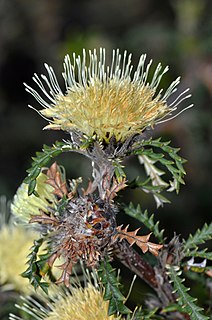
Banksia kippistiana is a species of shrub that is endemic to Western Australia. It has linear, pinnatifid leaves with ten to twenty lobes on each side, heads of up to eighty yellow and cream-coloured flowers, and elliptical follicles.
Banksia montana, commonly known as the Stirling Range dryandra, is a species of shrub that is endemic to the Stirling Range in Western Australia. It has hairy stems, linear pinnatisect leaves with twisted, triangular lobes, yellow flowers in heads of about sixty and reddish-brown follicles.
Banksia stenoprion is a species of prostrate shrub that is endemic to the south-west of Western Australia. It has short, underground stems, pinnatisect leaves with triangular lobes, golden, mauve or purple flowers in heads of up to ninety, and egg-shaped follicles.

Hakea orthorrhyncha, commonly known as bird beak hakea, is a shrub which is endemic to the Murchison River area of Western Australia.
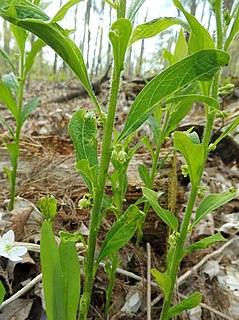
Hybanthus concolor, commonly known as eastern green violet, is a flowering plant in the violet family (Violaceae). It is native to eastern North America, where it is found through much of the interior areas of the eastern United States and Ontario, Canada.
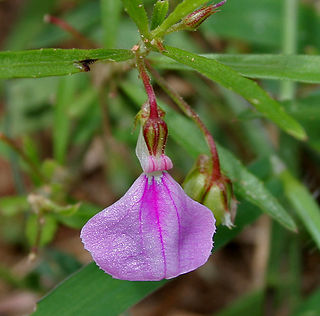
Hybanthus (greenviolet) is a genus of flowering plants in the family Violaceae. This genus name is Greek for "humpback flower", referring to the drooping pedicels of plants that are part of this genus. The genus is grossly polyphyletic and may contain up to nine different genera, of which Pombalia Vand., Cubelium Raf. and Pigea DC. have been previously recognised.
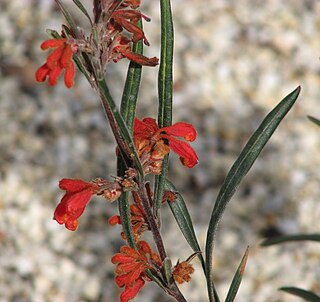
Grevillea bronwenae is a slender shrub that is endemic to the south-west of Western Australia.
Grevillea acuaria is a shrub which is endemic to the south of Western Australia.

Pultenaea muelleri is a shrub which is endemic to Victoria, Australia. The species is a member of the family Fabaceae and of the genus Pultenaea. It is a dense shrub that can grow to between 1 and 3 metres in height. The leaves are 10 to 20 mm long, 1 to 2 mm wide and have parallel veins and soft hairs on the undersides. The pea-shaped flowers, which are produced in terminal heads, are yellow with a red centre. These appear between October and January in the species' native range.

Adenanthos meisneri, commonly known as prostrate woollybush, is a species of shrub in the family Proteaceae. It is endemic to the south-west of Western Australia.
Eleanor Marion Bennett is an Australian botanist who was employed by the Western Australian Herbarium from 1965 to 1970. She collected Eucalyptus species in the south-west of Western Australia and published a revision of the genus Hybanthus in 1972. She is the author of two books: Bushland Plants of Kings Park, Western Australia and Common and aboriginal names of Western Australian plant species. Bennett was also one of the authors of Flora of the Perth region.

Hakea linearis is a shrub or tree in the family Proteacea and is endemic to Western Australia. It has smooth branches, mostly linear leaves and white flowers.

Hakea longiflora is a small shrub in the family Proteaceae and is endemic to Western Australia. It has sharp, short, needle-like leaves with white flowers and a prominent red style.

Isopogon longifolius is a small shrub in the family Proteaceae that is endemic to the southwest of Western Australia.
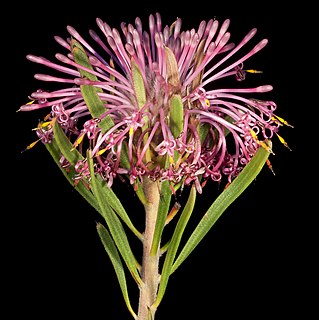
Isopogon linearis is a small shrub in the family Proteaceae that is endemic to the southwest of Western Australia.
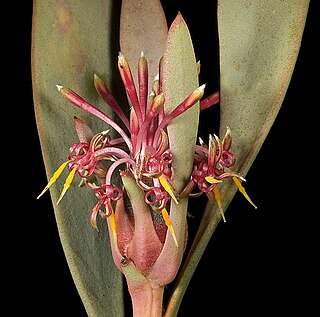
Isopogon pruinosus is a species of flowering plant in the family Proteaceae and is endemic to southwestern Western Australia. It is a compact, spreading shrub with narrow egg-shaped leaves with the narrower end towards the base and spherical to elliptic heads of pink flowers.

Hybanthus stellarioides, commonly known as spade flower is an annual herb of the genus Hybanthus, native to Australia.
















